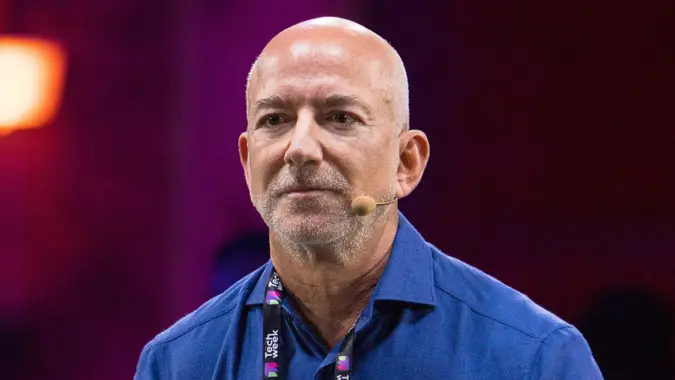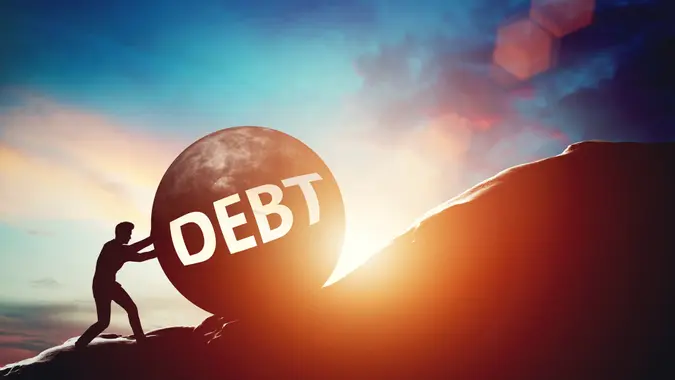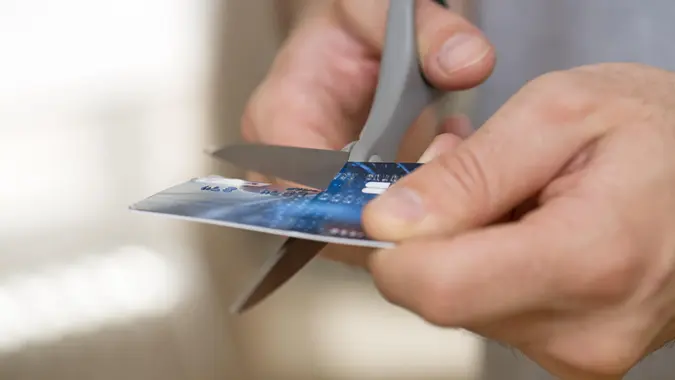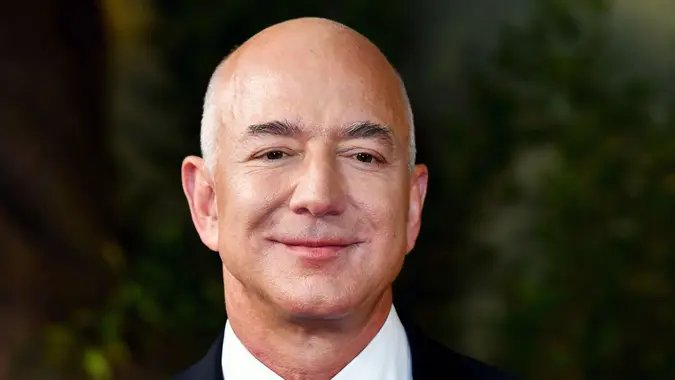How To Pay Off Debt Fast: 7 Strategies That Work in 2025

Commitment to Our Readers
GOBankingRates' editorial team is committed to bringing you unbiased reviews and information. We use data-driven methodologies to evaluate financial products and services - our reviews and ratings are not influenced by advertisers. You can read more about our editorial guidelines and our products and services review methodology.

20 Years
Helping You Live Richer

Reviewed
by Experts

Trusted by
Millions of Readers
According to an Experian consumer debt study, the average debt of Americans in 2024, including mortgages, credit cards, and auto, personal and student loans was $105,056. Tackling thousands of dollars of debt with added interest takes a plan, and goal setting plays an important part.
For the best results, you’ll need to establish your expectations and timeline so you can start making progress. Here’s what you need to know about best ways to pay off debt.
Top Mistakes That Keep You in Debt
Getting out of debt takes time and commitment. It also takes an awareness of mistakes that can keep you in debt. Here are some to be mindful of:
- Not tracking your spending: If you don’t know where your money’s going, you can’t control it.
- Spending more than you earn: Debt piles up when your income can’t cover your lifestyle.
- No emergency fund: Without savings, you may put surprise expenses on a credit card.
- Only paying the minimum: Minimum payments do little to reduce balances that accrue interest.
- Ignoring the debt: Avoiding it doesn’t fix it, and the debt will likely grow.
- No payoff plan: To be successful, you need a plan that will work for you and your budget.
- Using new credit cards while paying off debt: Racking up balances on new credit cards creates more debt — even while you’re paying off older ones.
Step 1: List Every Debt You Owe — and Interest Rate
Find a debt payoff worksheet or app, such as You Need a Budget (YNAB), to help you list all of your debt so you can track balances, payments and annual percentage rates. Prioritize paying off the most expensive debts first by looking at total cost with interest — not just the current balance.
Step 2: Choose a Debt Payoff Method That Fits Your Budget
Once you’ve listed all of your debts in detail, choose one of the following debt payoff methods that will work best with your budget:
| Debt Snowball | Debt Avalanche | Debt Hybrid |
|---|---|---|
| Pays smallest balance debt first | Pays highest interest debt first | Combines both strategies by applying what works |
| Results in quick wins | Results in interest savings | Results in flexibility |
| Good for motivation | Good for saving money | Good if your budget changes due to life circumstances |
Debt Snowball
Pay as much as you can toward the debt with the smallest balance first while continuing to only pay the minimum on all other debts. Once the first debt is paid, move on to the next-smallest debt, combining the payment amount from the debt you just paid off and the minimum payment you were already paying to bring down the balance more quickly. Repeat for all remaining debts.
Debt Avalanche
Pay as much as you can toward the debt with the highest interest rate while paying the minimum on all other debts. Once the highest-interest debt is paid off, combine the amount you were paying toward it with the minimum payment you were already paying toward the next-highest-interest debt until that debt is paid off. Repeat for all remaining debts.
Debt Hybrid
Use both strategies to make progress in a way that makes sense for you. For example, start with the debt snowball to quickly wipe out smaller debts and get some quick wins. Then, once only larger debts are left, switch to the debt avalanche method and prioritize interest savings.
Step 3: Build a Monthly Budget That Supports Debt Repayment
Your monthly budget needs to support debt repayment. The best way to ensure it does is to choose a budgeting method, such as the following:
- 50/30/20 budget: 50% of your budget goes to needs, 30% to wants and 20% to savings.
- Zero-based budgeting: Every dollar of your take-home pay has a job, so that there’s no unplanned spending or lack of saving.
Additionally, when building a budget, it can be helpful to identify all expenses that you can eliminate. A portion of your money — or all of it — that might be going toward unused subscriptions, food delivery fees and daily treats can all be redirected toward your debt.
Step 4: Earn Extra Income and Pay Off Debt Faster
Another effective way to pay off debt quickly is to take up a part-time job or side gig and put all of your earnings toward what you owe. Some of the best side hustles to make extra money include:
- Freelance writing
- Online tutoring
- Rideshare driving, such as Uber or Lyft
- Food delivery
- Pet sitting
Step 5: Use Balance Transfers and Personal Loans Strategically
If you have a lot of high-interest credit card debt, consider using balance transfers or personal loans to eliminate or reduce the interest.
Using a 0% Interest Credit Card
For example, you may be able to apply and get approved for a 0% balance transfer card that will allow you enough time to pay off a credit card balance that has high interest. Divide the total balance you’re transferring from the high-interest card by the number of months offered by the balance transfer card at 0% interest to find out the payment amount you’ll need to make each month.
Personal Loans With No Origination Fees or Prepayment Penalties
If a balance transfer card isn’t an option, a personal loan may be. When applying for a personal loan, be aware of any origination fees or prepayment penalties. Also, ensure that the interest rate offered will actually save you money if you use it to pay off your current debts.
Step 6: Set Payoff Goals With Milestones
Setting payoff goals with milestones can help keep you motivated. Break your debt into small, winnable amounts, such as $500 or $1,000.
Once you reach the goal, reward yourself with something that’s free or low cost.
Another option is to make time-related goals, such as completing six or 12 months’ worth of payments. Once you reach the milestone, give yourself a sensible reward. Use visual aids or tracking charts that you can create as an Excel spreadsheet to help keep you motivated.
Step 7: Get Professional Help If You’re Stuck
If tackling your debt is too overwhelming, don’t hesitate to get professional help. Nonprofit credit counseling services are a good option to help cease collection calls, consolidate bills into smaller monthly payments, lower interest rates and eliminate late fees and over-the-limit charges.
How To Pay Off Debt FAQ
Here are the answers to some of the most frequently asked questions about paying off debt fast.- What's the smartest way to pay off debt fast?
- The smartest way to pay off debt quickly is to list your debt balances and interest rates, create a budget to see how much you can put toward the debts, and choose a payoff strategy that will work best for you.
- How long does it take to become debt-free?
- The length of time it takes to become debt-free depends on the amount of your debts and how much money you can put toward them each month to pay them off.
- Can I pay off debt without ruining my credit?
- Paying off debt will not ruin your credit. In fact, it should improve your credit because it reduces your credit utilization ratio, which is a considerable percentage of your credit score. However, you might experience a slight drop in your credit score if paying off a debt, such as an auto loan, decreases the diversity of your credit mix.
- Should I close credit cards after paying them off?
- In general, it's better to keep credit cards open after paying them off. Closing credit cards can increase your credit utilization and decrease the average age of your accounts -- both of which count negatively toward your credit score.
Our in-house research team and on-site financial experts work together to create content that’s accurate, impartial, and up to date. We fact-check every single statistic, quote and fact using trusted primary resources to make sure the information we provide is correct. You can learn more about GOBankingRates’ processes and standards in our editorial policy.
- TransUnion. 2025. "Credit Industry Snapshot."
- United Nations Federal Credit Union. "Budgeting basics: The 50-30-20 rule."
- National Foundation for Credit Counseling. "Creating a Plan Today for a Brighter Tomorrow."
- Equifax. "Why Your Credit Scores May Drop After Paying Off Debt."
 Written by
Written by  Edited by
Edited by 

























